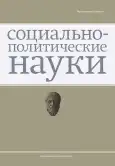The Influence of the United States of America on the Military-political Situation in East Asia in the Second Half of 1941: Historical and Political Analysis
- Авторлар: Ermakov D.N.1,2,3, Popov G.G.2,4, Kazenkov O.Y.1,2,3
-
Мекемелер:
- Institute of the Far East of the Russian Academy of Sciences
- M.F. Stelmakh Polyus Research Institute
- Engineering Academy of the Peoples’ Friendship University of Russia
- Institute of Social Sciences of the Russian Academy of National Economy and Public Administration (RANEPA) under the President of the Russian Federation
- Шығарылым: Том 12, № 2 (2022)
- Беттер: 106-118
- Бөлім: Articles
- URL: https://bakhtiniada.ru/2223-0092/article/view/146956
- DOI: https://doi.org/10.33693/2223-0092-2022-12-2-106-118
- ID: 146956
Дәйексөз келтіру
Аннотация
Толық мәтін
##article.viewOnOriginalSite##Авторлар туралы
Dmitry Ermakov
Institute of the Far East of the Russian Academy of Sciences; M.F. Stelmakh Polyus Research Institute; Engineering Academy of the Peoples’ Friendship University of Russia
Email: ermakov@ifes-ras.ru
Dr. Sci. (Econ.), Dr. Sci. (Polit.); Cand. Sci. (Hist.), Professor, Master of Technical Sciences; chief researcher at the Center for World Politics and Strategic Analysis of the Institute of the Far East Moscow, Russian Federation
Grigory Popov
M.F. Stelmakh Polyus Research Institute; Institute of Social Sciences of the Russian Academy of National Economy and Public Administration (RANEPA) under the President of the Russian Federation
Email: ggpopov2009@mail.ru
Cand. Sci. (Econ.); senior researcher at the Postgraduate Department JSC “M.F. Stelmakh Polyus Research Institute”; senior researcher at the Center for the Study of Military Economics of the School of Actual Humanitarian Studies of the Institute of Social Sciences Moscow, Russian Federation
Oleg Kazenkov
Institute of the Far East of the Russian Academy of Sciences; M.F. Stelmakh Polyus Research Institute; Engineering Academy of the Peoples’ Friendship University of Russia
Email: o.kazenkov@gmail.com
Honorary Worker of Education of the Russian Federation; assistant to the General Director for Strategic Communications at the JSC “M.F. Stelmakh Polyus Research Institute”; Deputy Head at the Center of NTI “Photonics” Moscow, Russian Federation
Әдебиет тізімі
- History of the Pacific War. In 5 vols. U. Seidziro, E. Bokuro, T. Sigeki, N. Siro. M. Eiithi (gen. eds.). B.V. Pospelov (ed.). Transl. from Japanese by L.Z. Levin, V.I. Rodionov, V.I. Shipaev. Moscow: Publishing House of Foreign Literature, 1958. T. IV. Second period of the war.
- Koshkin A.A. “Kantokuen” - “Barbarossa” in Japanese. Moscow: Veche, 2011.
- Krivosheev G.F. et al. The Great Patriotic War without the stamp of secrecy. The book of losses. Moscow: Veche, 2010.
- Ragozin D.V. American-Chinese economic cooperation during the war with Japan. Tomsk State University Bulletin. 2016. No. 403. (In Rus.) Pp. 108-116. doi: 10.17223/15617793/403/18
- Central Archive of the Ministry of Defense of the Russian Federation. F. 500. Inv. 12451. Case 258.
- Central Archive of the Ministry of Defense of the Russian Federation. F. 500. Inv. 12451. Case 286.
- Aizawa K. Japanese strategy in the first phase of the Pacific War // International Forum on War History. Eighth Forum. Tokyo, 2009.
- Asada S. From Mahan to Pearl Harbor: The imperial Japanese navy and the United States. Annapolis (Md.): Naval Institute Press, 2006.
- Babb J.G.B. The harmony of Yin and Yank: The American military advisory effort in China, 1941-1951. PhD dis. USA: University of Kansas, 2012. 305 p.
- Burtness P.S., Ober W.U. Provocation and angst: FDR, Japan, Pearl Harbor, and the entry into war in the Pacific // The Hawaiian Journal of History. 2017. No. 51. Pp. 91-114.
- Cohen W. American leaders and East Asia, 1931-1938 // American, Chinese, and Japanese perspectives on wartime Asia 1931-1949. Wilmington (Del.): A Scholarly Resources Imprint, 1989.
- Feis H. The road to Pearl Harbor. Princenton, 1950.
- Foreign Relations of the United States. Diplomatic Papers, 1939. The Far East. Vol. III. Washington (DC): Government Printing Office, 1955. URL:https://history.state.gov/historicaldocuments/frus1939v03/ch8
- Foreign Relations of the United States. Diplomatic Papers, 1940. The Far East. Vol. IV. Washington (DC): Government Printing Office, 1955. URL:https://history.state.gov/historicaldocuments/frus1940v04/ch3subch5
- Hall S. Blinded by the rising sun. Japanese military intelligence from the First Sino-Japanese war to the end of World war two. PhD Theses. Australia. University of Adelaide. 2016. 412 p.
- Hasegawa T. Soviet policy toward Japan during World War II // Cahiers du monde Russe. 2011. Vol. 52. No. 2-3. URL:http://journals.openedition.org/monderusse/9333; DOI: https://doi.org/10.4000/monderusse.9333.
- Herzog J.H. Influence of the United States navy in the embargo of oil to Japan, 1940-1941 // Pacific Historical Review. 1966. Vol. 35. No. 3.
- Ienaga S. Japan’s last war. World War II and the Japanese, 1931-1945. Canberra: Australian national university press, 1979.
- Japanese preparations for operations in Manchuria (prior to 1943). Tokyo: Office of the Chief of Military History, Dept. of the Army, 1954. 67 p.
- Nakagawa R. Japan-U.S. Trade and rethinking the point of no return toward the Pearl Harbor // Ritsumeikan Annual Review of International Studies. 2010. Vol. 9. Pp. 101-123.
- Reports of General MacArthur. The campaigns of MacArthur in the Pacific. Vol. I. Washington (DC): Harold K. Johnson, 1966. [CMH Pub. 13-3].
- Russett B.M. No Clear and present danger: A skeptical view of U.S. entry into World War II. New York: Harper and Row, 1972.
- Sagan S.D. The origins of the Pacific war // The origin and prevention of major wars. R.I. Rotberg, T.K. Rabb (eds.). New York: Cambridge University Press, 1989.
- Shaohai G. Japan’s War on three fronts prior to 1941 // Bound Away: The Liberty Journal of History. 2020. Vol. 3. Iss. 1. URL:https://digitalcommons.liberty.edu/ljh/vol3/iss1/2
- Stille M. Yamamoto Isoroku (Command). Osprey Publishing. 2012.
- Tajima N. Tripartite Pact between Japan, Germany and Italy // International Forum on War History: Proceedings. 2016.
- The “Magic” background of Pearl Harbor. Vol. 5. Washington (DC): Government Printing Office, 1977.
- Wohlstetter R. Pearl Harbor: Warning and Decision. Stanford (CA): Stanford University Press, 1962.
Қосымша файлдар








